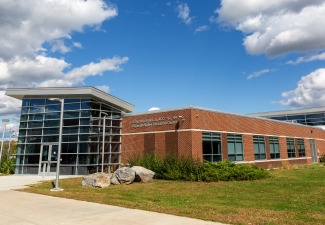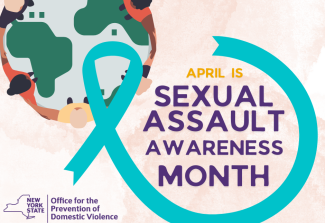SUNY Plattsburgh National Day of Racial Healing Brings Together Campus, Community
The chief of psychology at the University of Vermont Health Network, Champlain Valley Physician’s Hospital, Plattsburgh, said that no one has the same recipe for wellness and psychological resilience.
Dr. Aron Steward told participants of SUNY Plattsburgh’s observance of the National Day of Racial Healing that when helping marginalized populations increase the skills and practices that build resilience, it’s crucial that communities inform themselves about generational trauma and withhold judgement.
Steward was at the day-long series of workshops and healing circles to present, “Building Courage: Applying Strategic Resilience to the Seemingly Insurmountable Tasks We Have Ahead.”
The forensic psychologist specializes in reduction of aggression and violence, limiting maladaptive behaviors in patients and trauma prevention and intervention. At CVPH, she has been instrumental in helping create its critical incident debrief team to build and support a resilient culture by reducing vicarious and secondary trauma.
“The majority of oppressed and marginalized populations have been dealing with intergenerational
fatigue for a very long time,” she said during her breakout session. “It’s not willpower.
It’s how much energy you have when you face your adversities that indicates how you
will navigate through.”
It can be difficult for people from more privileged backgrounds to understand these difficulties, she said.
Changing Psychology
In the late ‘90s and early 2000s, psychologists thought the ideal was bouncing back from adversity as quickly as possible, Steward said.
Now, psychologists advise using internal and external opportunities and tools to figure out how to mitigate the downpour and make it a drizzle since human physiology prefers a moderate amount of stress to either an excessive amount or none at all, she said.
“Courage is bravery in the face of adversity, regardless of if we want to face it or not,” Steward said.
“It doesn’t come naturally to our physiology as humans to see adversity as an opportunity for growth.”
She offered the audience suggestions for ways they can care for themselves. What works for each person is different: Socializing regularly in large groups might not mentally restore introverts, for instance, she said.
History of National Day of Racial Healing
The National Day of Racial Healing is an annual observance hosted by the W.K. Kellogg
Foundation and was created with and builds on the work and learnings of the Truth,
Racial Healing and Transformation community partners, including SUNY Plattsburgh.
Held the Tuesday after Martin Luther King Jr. Day, the event is hailed as a time to
contemplate shared values, bringing all people together in a common humanity, inspiring
a collective action to create a just and equitable world.
SUNY Plattsburgh’s commemoration, co-sponsored by Diversity, Equity and Inclusion, the University of Vermont Health Network, Unitarian Universalist Fellowship, North Country Underground Railroad and Plattsburgh College Foundation, began Tuesday morning with a keynote session, “The Heart of Racial Equity Starts with Courage,” then moved into concurrent sessions on themes of racial healing.
A noontime series of roundtable discussions brought groups together to discuss topics as varied as “Sharing Your Superpowers,” “Finding Common Ground,” “Teach With Courage on Racial Equity,” “Strategic Message Framing: Intent vs. Impact,” and “Eliminating Implicit Bias and Strengthening Principled Policing.”
Afternoon sessions included racial healing circles and a healing circle facilitator workshop. The closing presentation, “Healing Soul Wounds,” featured Dr. Marissa Coleman, vice president of diversity, equity and inclusion and licensed clinical psychologist at the University of Vermont, discussing “Post Traumatic Slave Syndrome,” a condition that exists as a consequence of multigenerational oppression of Africans and their descendants resulting from centuries of slavery.
‘Community, Sense of Connection’
Alberto Muir, a mental health technician at CVPH and part of the hospital’s diversity committee, listened to Steward’s talk on building courage.
“I liked the connection part of it,” he said. “I can apply it to my life, to my experiences.” His take-aways, he said, included “the sense of belonging, finding your niche in life.”
“From there, you feel like you’re doing something for someone. The community, you’re part of something bigger. The sense of connection is big for me,” he said.
Originally from Costa Rica, Muir earned both his bachelor’s and master’s degrees from SUNY Plattsburgh. He said programs like Steward’s are part of what will help break down the stigma about mental illness over time.
“Make it more a normal conversation. It’s (mental health care) not just for certain people, everyone has problems at some point.”
‘Different Voices’
In her preparations for SUNY Plattsburgh’s commemoration day, Allison Heard, vice president of diversity equity and inclusion at the university, reached out to the event co-sponsors to schedule speakers that supported the third and fourth pillars of the university’s strategic plan: prioritizing equity and inclusion, and engaging the North Country region.
A goal was to highlight speakers and group facilitators who the campus doesn’t hear
from as often as others, Heard said.
“Our messaging today is all embedded in different voices,” she said.
Coleman delivered her portion of the program via Zoom. At UVM, she specializes in post-traumatic adjustment and survivors of childhood abuse. Her research interests include health disparities in communities of color, international psychology and human rights, and trauma recovery.
‘Post Traumatic Slave Syndrome’
In her talk, she explained how post traumatic slave syndrome arises from the experience of slavery that has been carried across the generations down to the present day, along with the stress of contemporary racial prejudice. This manifests as a psychological, spiritual, emotional, and behavioral syndrome that results in a lack of self-esteem, persistent feelings of anger, and internalized racist beliefs.
“There are clear connections between survival behavior and the African American experience,” Coleman said. “(But) If trauma is inherited, which is well researched and proved, so is resilience; so is strength. Instead of looking at any minoritized group as broken, rejected people, why not focus on the strengths and resilience — the way behind the behavior. When we do, I know we will see the brilliance passed down the generations, the fortitude and strength and also the joy, the ways we’ve had to find humor, laugher and music and all the ways the world has come to love the community.”
Prior to the keynote address by Michelle Ouellette, associate professor in public relations, senior Angelina Briggs, president of Black Onyx, the Black student union, addressed attendees, explaining how the day is meaningful for her.
“I am very involved on campus,” Briggs said. “This day again is not only just for us as students but for you to better yourself as faculty, as staff members in your daily lives as you see POC (people of color) students and POC in general.”
‘Change Has to Start with Us’
Ouellette went on to encourage the group to engage in difficult conversations instead of scrolling social media or working around the clock.
“While we are flawed, we are enough. We have what it takes,” Ouellette said. “Change has to start somewhere. We are imperfect beings. It has to start with us. In a space we make brave.”
Ouellette shared a story about a student who shared with her about why he didn’t speak out in class during a time racial upheaval on campus.
“He wanted to make room for marginalized voices. They wanted, needed the space (to speak). But they also wanted, needed his voice. It was not an ‘either, or.’ It was a ‘yes and.’ And, truthfully, if he spoke out, he might have gotten criticized. But, yet, as an ally, it was needed. How often do we find ourselves in a situation like this? With race, gender, class, being human? Can we speak sensitively but also leave room for the voices that need to be heard?” Ouellette said.
“The young man did not speak on that first day when he was lost and didn’t know what to do. But he did speak on another day and that mattered.”
— Story and photos by Associate Director of Communications Gerianne Down
and Assistant Director of Communications Felicia Krieg
News
Learning Center Helps Keep Students on Track From First Year through Graduation
SUNY Plattsburgh, NCCC Announce New Admissions Initiative
Alumni Celebrated for Sustained Support of North Country, Residents

SUNY Adirondack Students Benefit from New Dual Agreement with SUNY Plattsburgh Queensbury

SUNY Recognizes Two Plattsburgh Seniors for Excellence in Academics, Leadership
